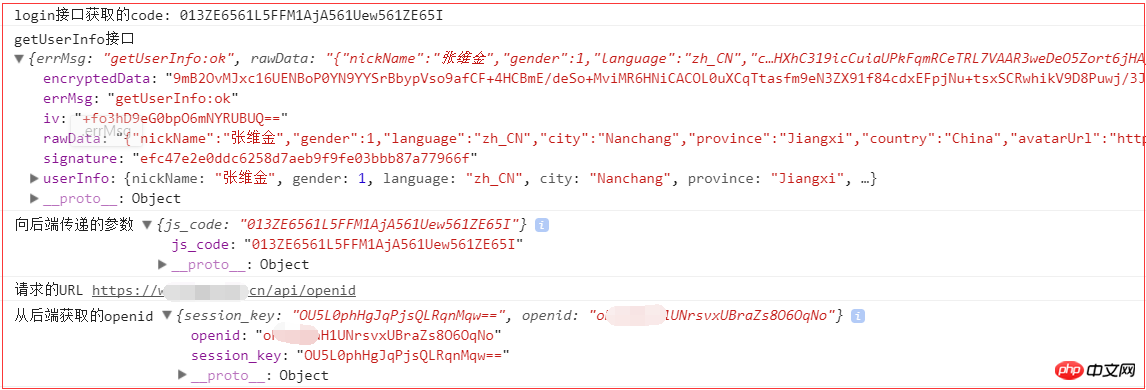Home >WeChat Applet >Mini Program Development >How to obtain user session_key, openid, unioni in WeChat applet (code)
How to obtain user session_key, openid, unioni in WeChat applet (code)
- 不言Original
- 2018-09-07 16:26:276250browse
Obtain user session_key, openid, and unioni in the WeChat mini program. This is a function that can often be seen in mini programs. So how to implement the mini program to obtain session_key, openid, and unionid; this article will introduce to you about the backend. The node.js WeChat applet implements the method of obtaining user session_key, openid, and unionid.
Steps:
1. Obtain the code and jscode through the wx.login interface and pass it to the backend;
2 , backend request
https://api.weixin.qq.com/sns/jscode2session?appid=APPID&secret=SECRET&js_code=JSCODE&grant_type=authorization_code
address, you can get the openid and unionid .
Mini program interface promise and encapsulation
1. Create the wechat.js file in the utils folder
/**
* Promise化小程序接口
*/
class Wechat {
/**
* 登陆
* @return {Promise}
*/
static login() {
return new Promise((resolve, reject) => wx.login({ success: resolve, fail: reject }));
};
/**
* 获取用户信息
* @return {Promise}
*/
static getUserInfo() {
return new Promise((resolve, reject) => wx.getUserInfo({ success: resolve, fail: reject }));
};
/**
* 发起网络请求
* @param {string} url
* @param {object} params
* @return {Promise}
*/
static request(url, params, method = "GET", type = "json") {
console.log("向后端传递的参数", params);
return new Promise((resolve, reject) => {
let opts = {
url: url,
data: Object.assign({}, params),
method: method,
header: { 'Content-Type': type },
success: resolve,
fail: reject
}
console.log("请求的URL", opts.url);
wx.request(opts);
});
};
/**
* 获取微信数据,传递给后端
*/
static getCryptoData() {
let code = "";
return this.login()
.then(data => {
code = data.code;
console.log("login接口获取的code:", code);
return this.getUserInfo();
})
.then(data => {
console.log("getUserInfo接口", data);
let obj = {
js_code: code,
};
return Promise.resolve(obj);
})
.catch(e => {
console.log(e);
return Promise.reject(e);
})
};
/**
* 从后端获取openid
* @param {object} params
*/
static getMyOpenid(params) {
let url = 'https://xx.xxxxxx.cn/api/openid';
return this.request(url, params, "POST", "application/x-www-form-urlencoded");
};
}
module.exports = Wechat;2. Modify the app.js file of the mini program
let wechat = require('./utils/wechat.js');
App({
onLaunch() {
this.getUserInfo();
},
getUserInfo() {
wechat.getCryptoData()
.then(d => {
return wechat.getMyOpenid(d);
})
.then(d => {
console.log("从后端获取的openid", d.data);
})
.catch(e => {
console.log(e);
})
}
})The back-end nodejs is a project framework generated using the express command line,
1. Create a common folder, create a utils file, use the request module to request the interface, and promise the request
const request = require("request");
class Ut {
/**
* promise化request
* @param {object} opts
* @return {Promise<[]>}
*/
static promiseReq(opts = {}) {
return new Promise((resolve, reject) => {
request(opts, (e, r, d) => {
if (e) {
return reject(e);
}
if (r.statusCode != 200) {
return reject(`back statusCode:${r.statusCode}`);
}
return resolve(d);
});
})
};
};
module.exports = Ut;2. Add a new route, and obtain the appId and secret in the background of the mini program.
router.post("/openid", async (req, res) => {
const Ut = require("../common/utils");
try {
console.log(req.body);
let appId = "wx70xxxxxxbed01b";
let secret = "5ec6exxxxxx49bf161a79dd4";
let { js_code } = req.body;
let opts = {
url: `https://api.weixin.qq.com/sns/jscode2session?appid=${appId}&secret=${secret}&js_code=${js_code}&grant_type=authorization_code`
}
let r1 = await Ut.promiseReq(opts);
r1 = JSON.parse(r1);
console.log(r1);
res.json(r1);
}
catch (e) {
console.log(e);
res.json('');
}
})Result:

This return result does not have a unionid. According to the official statement, it needs to be sent to WeChat Open platformBind mini program;
Related recommendations:
How to get the user’s openid from WeChat mini program
# #Introduction to how to obtain the parameters openid & session_key in the mini program
The above is the detailed content of How to obtain user session_key, openid, unioni in WeChat applet (code). For more information, please follow other related articles on the PHP Chinese website!
Related articles
See more- WeChat Mini Program Simple DEMO layout, logic, and style exercises
- Detailed explanation and examples of WeChat applet wx.request (interface calling method)
- WeChat Mini Program - Detailed explanation of WeChat login, WeChat payment, and template messages
- WeChat applet (application account) simple example application and detailed explanation of the example
- Detailed explanation of WeChat applet for loop

